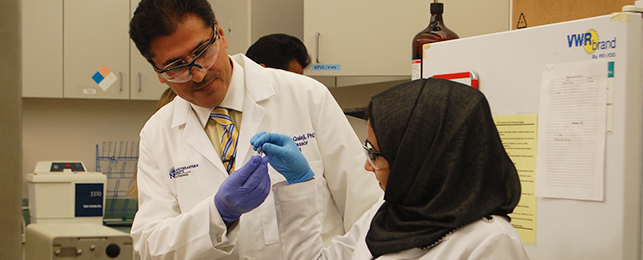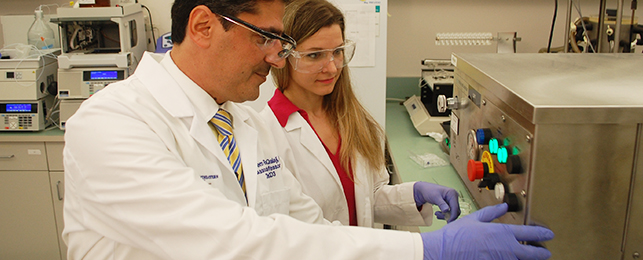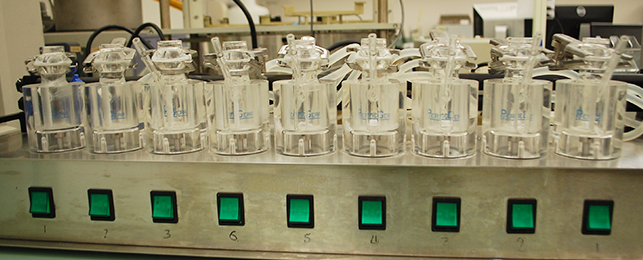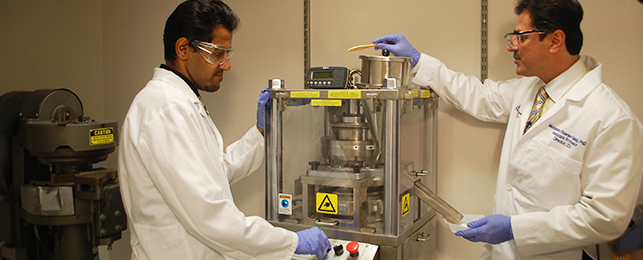Pharmaceutical Researcher Creates New Epinephrine Tablet
By creating the new epinephrine tablet, Mutasem Rawas-Qalaji, Ph.D., fills a need in the health-consumer market–a development that may drastically improve the lives of children and adults who require epinephrine to combat severe allergic reactions.
“When I started this research project, I experienced the stress that the parents of children with allergies go through,” said Rawas-Qalaji, pharmaceutical researcher and associate professor at Nova Southeastern University (NSU) Barry and Judy Silverman College of Pharmacy. “There is always a fear associated with these type of reactions. I felt that I could utilize my experience, education, and training to make a difference in the lives of these patients.”
The epinephrine tablets developed by Rawas-Qalaji with the help of his Ph.D. and Pharm.D. students at NSU are sublingual tablets that disintegrate very quickly under the patient’s tongue and release epinephrine to be absorbed directly into the blood stream. They offer a convenient, patient-friendly, and less invasive method to self-administer epinephrine and a potential reduction in patient anxiety, errors, and cost.
Anaphylaxis is a severe and potentially fatal allergic reaction requiring immediate treatment. Foods such as peanuts, fish, and shellfish; products such as latex; and some medications are causes of anaphylactic shock.
“Unfortunately, the onset of anaphylactic reactions is very rapid,” Rawas-Qalaji said. “Usually, the patient has some red rashes and might experience some wheezing, difficulty breathing, and abdominal discomfort like cramps, diarrhea, or vomiting. When the patient starts to feel these symptoms, it’s important to administer epinephrine immediately.”
Today, the only available self-medication is an epinephrine auto injector–commonly known as EpiPen®–whose consumers have seen a 500 percent price increase in 10 years.
“Some patients don’t like to inject themselves and sometimes there’s an anxiety associated with administering the epinephrine injection,” Rawas-Qalaji said. “The new tablet will break down in a few seconds under the patient’s tongue. It releases and ensures that the drug will be available for absorption through the sublingual mucosa. It can reach the same concentration achieved by the injection.”
Epinephrine tablets are less bulky, easier to handle, and have a longer shelf life than epinephrine injections.
“In our preclinical testing, these tablets demonstrated no safety concerns. However, the safety needs to be confirmed and well-demonstrated in clinical trials before the tablets can be approved by the U.S. Food and Drug Administration (FDA),” Rawas-Qalaji said.
“We are working to advance the product development and finish clinical trials as soon as it is feasible. If we are able to show the same safe efficacy level as in the preclinical studies, I think we will be very close to putting this product on the market by 2020.”
Working in the area of drug formulation and drug delivery, “I try to find novel ideas and formulations,” he said. “I hope toward the end of this research journey, parents and children can feel secure and enjoy life with the assurance that they have a tablet in their pocket that can save their lives if and when they need it.”
Partner With Us: To learn how you and your organization can partner with NSU on this and other innovative and marketable technologies, contact Gary Margules, Sc.D., NSU vice president of research and technology transfer, at margules@nova.edu or (954) 262-7507.



